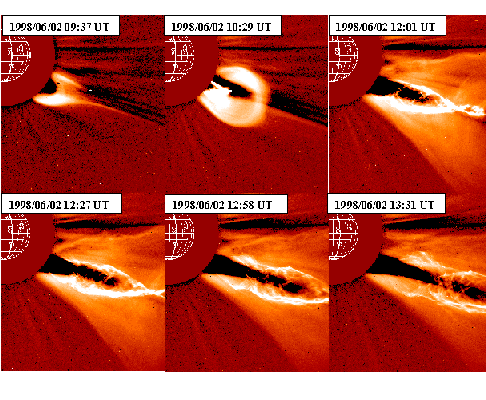| |
About CMEs
A coronal mass ejection (CME) has been defined as "An observable change in coronal
structure that (a) occurs on a time scale between a few minutes and several hours and
(b) involves the appearance of a new discrete bright light feature in the
coronagraph field of view" (Hundhausen 1984). This definition of CMEs has been very
widely accepted to be the most appropriate one as it stresses on the observational
aspect and the transient nature of the phenomena while eluding the interpretation
of the feature itself and its potential origin.
CMEs form an exciting topic of current research and they are among the major science
objectives of the SOHO mission and the LASCO instruments in particular. A typical
example of a CME as observed in whitelight by LASCO-C2 coronagraph on June 2, 1998
is shown below. The field of view here is 2-6 Rsun.
 Some of the key questions that remain unsettled are outlined below:
Some of the key questions that remain unsettled are outlined below:
- What are the origins of the CMEs?
- Where and how are they accelerated?
- Do fast CMEs accelerate differently than the slow ones?
In order to help answer these questions, it is important to know that there are several
types of CMEs. Broadly, there are two kinds of classification of CMEs, based on
observations by several past and present space coronagraphs.
One classification is based on the kinematic properties of CMEs (MacQueen and Fisher, 1983)
and the other on the structure and morphology (Howard et al. 1985).
The former classification is based on measurements of flow speeds and acceleration
in CMEs and is of utmost importance in understanding the initiation and propagation
of CMEs.The speeds of CMEs are known to typically lie in the range 50-2000 km/s.
MacQueen and Fisher (1983) classified CMEs, based on the kinematics of a large number of
coronal transients observed from both the space coronagraph on Skylab and a
ground based coronagraph. Under this classification, CMEs can be divided in
the following two major classes:
- Fast events or flare-associated events that start with high speeds ~ 700 km/s
and show no acceleration 0.3 m/s2
- Eruptive or slow events that start with low speeds of the order of 10-20 km/ s
and attain some value of acceleration which range between 0-50 m/s2.
Dr. Nandita Srivastava
|
